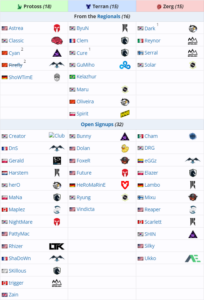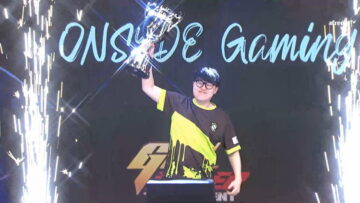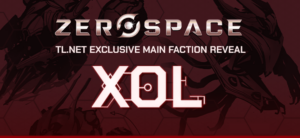The Greatest Players of All Time
By: MizenhauerThis impossible question lies at the core of this list. While there is some common ground most StarCraft II fans can agree upon, over a decade of internet debate has made it clear that much of what defines greatness is inherently subjective. Thus, as I begin this series, I will try to explain my core values and criteria for greatness in StarCraft II, and how I tried to apply them consistently to all the players considered.
Before I go on and elaborate, I want to say what an honor it was to be able to write this series. I always wanted to do something of this nature at some point and, now that we are almost a decade removed from stuchiu’s seminal GOAT series, it seemed the perfect time to reflect on StarCraft II history and all the incredible players that made the game what it is.
I want to personally thank Lichter, Munch, Olli, CosmicSpiral, thehexhaven, TheOneAboveU and Soularion for making me feel at home when I signed on. I’d also like to thank my long-time editor Waxangel, as well as all the staff who have kept his place running all these years. I wouldn’t have a place to write without you. Lastly, I want to say thank you to those who have read my work over the past seven years. Being a part of this site and this community has been a life altering experience. With that said, I hope you will enjoy the next ten articles.
How to compare achievements & statistics from different eras
Any list such as this one will have to compare players who competed in vastly different eras. In order to mitigate the subjectivity that comes with making statistical 'conversions' between time periods, my starting point was to group players by time-period and compare them against their peers.Here are the four main divisions:
- 2010 to 2012: Pre-KeSPA/WoL
- 2013-2015: "Peak" KeSPA/HotS
- 2016-2017: Early LotV
- 2018 and later: Post-KeSPA
Key criteria: Major tournament finishes and win-rates
Tournament placements are a go-to measure of success in any sport, and they played a key part in player evaluations. It should be noted that I valued second place and top four finishes more highly than most fans (at least from what I've gathered from the StarCraft community over the years). My valuation was closer to the current EPT points distribution for major events (3 to 2 ratio for 1st vs 2nd place) than it was to the GSL points split (2 to 0.99 ratio).I also put a heavy weight on win-rates in major tournament series (GSL, SSL, Proleague) during players' prime years. Tournament placements, while an identifier of success, may not accurately reflect a player's standing in the scene during a given period, or sufficiently differentiate between players with similar finishes. Over a large sample, win-rates in major events helped capture the level of dominance a player exerted.
Deciding the duration of a player's prime was somewhat arbitrary, but for the most part, I believe readers will not find the selected endpoints to be objectionable. Overall, the win-rates from the sampled time frames remained similar between players, and care was taken so no player received an 'unfair' boost from cherry-picked endpoints.
Great career vs great peaks
One of the core dilemmas in compiling this list was how to value a player's total career accomplishments—largely measured by cumulative tournament finishes, versus their peak ability—largely measured by major tournament win-rates during their prime.Ultimately, I decided on around a 55:45 split, favoring the overall career slightly.
In the present situation where players have racked up long tournament resumes over 10+ years, I still tried to look at shorter careers (2-4 years) favorably as long as the player was clearly one of the best in the world while active. Players with significant periods of 'non-prime' years before and/or after their peaks still accumulated career credit for occasional deep tournament runs.
![[image loading]](https://platoaistream.com/wp-content/uploads/2024/01/greatest-players-of-all-time-intro.jpg)
Presented without comment.
Weighing Tournaments
Not all tournaments are created equal, and the exact valuation of tournaments often lies at the core of GOAT debates in the community. Acknowledging that it's impossible to be perfectly consistent, I tried to stick with the following rubric for weighing events.The gold standard - Code S/OSL/SSL aka "Korean Individual Leagues": The majority of the candidates for the GOAT list were primarily active in Korea during their careers, making tournament finishes and win-rates from these leagues a key measure of success for this series.
GSL Code S has undergone some changes over the years, but it has been, by far, the most stable tournament series in terms of format and level of competition. This made it an invaluable resource in comparing player results over a large number of games and tournaments.
SSL and OSL were considered to be equivalent to GSL Code S, and I collectively referred to them as "Korean Individual Leagues." Although OSL and SSL have become somewhat forgotten over time, they drew from identical player pools as the GSL and often offered similar prize money + world championship seeding incentives.
Exceptions: SSL 2017 and Code S 2023 had their values adjusted downward due to significant reductions in scale.
World championships (BlizzCon, IEM World Championship, WESG, Gamers8, etc): I rated world championship-tier tournaments to be equivalent or slightly more valuable than Korean Individual Leagues, depending on the specific tournament.
While I acknowledged the high level of prize money and prestige of these tournaments, the level of competition and rigorousness of the format were sometimes lacking compared to Korean Individual Leagues. For example, the 2014-15 IEM World Championships were held in a variance-heavy, 16-player single elimination format, while BlizzCon tournaments from 2016-2017 had an 8-player quota for WCS-region players in a period where Neeb was the only one who was competitive.
The emergence of Serral and Reynor made later world championship-tier events more valuable, as they featured rigorous formats, the highest prize money, and the most competitive player pools. For that reason, I viewed world championships from 2018 to the present day as more valuable than most world championship-tier events of the past.
For the sake of this ranking, the 2013 WCS Global Finals is the first event that has both the level of competition and amount of prize money required to be considered a 'true' world championship. Only IEM World Championships from 2014 and onwards are considered world championship-tier for the sake of player evaluation (also excluding IEM Katowice 2016 which was a region-locked WCS event).
Despite the weak player pools at the WESG tournaments in 2017-18, I considered them to be worth just slightly less than a season of Korean Individual Leagues or an average ESL/Blizzard world championship. This is due to the significant amount of prize money that would have made it a high priority for players at the time.
Going forward, if Gamers8 continues to hold events in the manner they did in 2023, I would consider those to be relatively similar to WCS and IEM World Championship from 2018 to the present.
KeSPA Proleague: For players who were active at the time, their records and win-rates from Proleague were valued similarly to that of Korean Individual Leagues.
Proleague was the engine fueling the Korean pro StarCraft I & II scenes for much of their existence, with corporate teams such as KT Rolster, Samsung Galaxy Khan, and SK Telecom paying large salaries to strong Proleague performers. While individual leagues hold more narrative sway, Proleague was at least equivalent to them in terms of practical importance.
The hybrid BW/SC2 half-season of Proleague in 2012 was not considered.
2020-2023 ESL Masters/DreamHack Season Finals: These events were valued similarly to Code S. The online versions of these tournaments played during the pandemic-era were not penalized, as they were still some of the most competitive and high-prize tournaments players were able to compete in at the time.
Super Tournaments, KeSPA Cups, and other miscellaneous Korean events: These tournaments were judged on a case-by-case basis, as the number of players, prize money, and rigorousness of format varied greatly. The majority of them fell into the so-called "tier 2" category, and were not valued highly.
However, some events, such as GSL Super Tournament 2011, were deemed to be similar or equivalent in stature to a Korean Individual League.
Miscellaneous Global Events: This contains an incredibly wide variety of tournaments with different formats, player pools, and prize money. While it would be necessary to parse the value of individual events to rank players #11 and below in the GOAT standings, it conveniently worked out so that these events were not particularly relevant to my top ten for the following reasons:
2013-2019 tournaments: Most of my top 10 GOAT players rarely competed in these events (if at all) due to their KeSPA affiliations. Also, most of the events during this period (IEM and DreamHack weekenders) were significantly less prestigious than Korean Individual Leagues, due to weaker player pools and lower prize money.
2010-2012: A handful of global tournaments during the Wings of Liberty period reached Code S quality in terms of prize money, player pools, and prestige. Examples of such events include MLG Providence 2011, IPL4, and IPL5. While the winners of these events received commensurate credit, it didn't end up having any bearing on the final GOAT top ten (Example: Leenock's IPL5 and MLG Providence wins were considered Code S-tier, but they weren't enough to push him into the top ten).
![[image loading]](https://platoaistream.com/wp-content/uploads/2024/01/greatest-players-of-all-time-intro-1.jpg)
How much respect is due to the past?
Terminology
Premier event/Premier tournament: When the word "premier" is used describe a tournament throughout this series, it refers to a tournament with Premier designation according to LiquipediaKorean Individual League: GSL Code S, OnGameNet Starleague (OSL), and StarCraft II Starleague (SSL).
Global Event: A tournament in which there was no region-lock or other significant geographical/nationality-based barrier to participation. This largely consists of so-called "Weekender" events such as old DreamHack Open Tournaments or IEM Circuit events.
- SEO Powered Content & PR Distribution. Get Amplified Today.
- PlatoData.Network Vertical Generative Ai. Empower Yourself. Access Here.
- PlatoAiStream. Web3 Intelligence. Knowledge Amplified. Access Here.
- PlatoESG. Carbon, CleanTech, Energy, Environment, Solar, Waste Management. Access Here.
- PlatoHealth. Biotech and Clinical Trials Intelligence. Access Here.
- Source: https://tl.net/forum/starcraft-2/619845-greatest-players-of-all-time-intro
- :has
- :is
- :not
- :where
- $UP
- 10
- 1st
- 2011
- 2012
- 2013
- 2014
- 2016
- 2017
- 2018
- 2023
- 2nd
- a
- Able
- According
- Accumulated
- accurately
- achievements
- acknowledged
- active
- Adjusted
- affiliations
- After
- against
- aka
- All
- almost
- also
- Although
- always
- amount
- an
- and
- any
- Apply
- ARE
- around
- articles
- AS
- At
- average
- barrier
- basis
- BE
- become
- been
- before
- begin
- being
- believe
- below
- BEST
- Better
- between
- boost
- both
- but
- by
- CAN
- candidates
- capture
- care
- Career
- careers
- Category
- championship
- championships
- Changes
- clear
- clearly
- closer
- code
- collectively
- comes
- comment
- Common
- community
- compare
- compared
- comparing
- comparisons
- compete
- competed
- competition
- competitive
- Consider
- considered
- consistent
- consistently
- consists
- contains
- continues
- conveniently
- conversions
- Core
- Core values
- Corporate
- course
- created
- credit
- criteria
- Current
- day
- debate
- debates
- decade
- decided
- deemed
- deep
- Defines
- Depending
- describe
- designation
- DID
- didn
- different
- differentiate
- dilemmas
- directly
- distribution
- do
- Dominance
- downward
- due
- duration
- during
- Early
- editor
- Elaborate
- emergence
- end
- endpoints
- Engine
- enjoy
- enough
- equal
- Equivalent
- ESL
- etc
- Ether (ETH)
- evaluation
- evaluations
- Event
- events
- example
- examples
- excluding
- experience
- Explain
- fans
- far
- featured
- feel
- final
- Find
- First
- following
- For
- forgotten
- format
- Forward
- four
- from
- fueling
- Galaxy
- game
- Games
- gathered
- given
- Global
- Go
- Gold
- Gold Standard
- great
- greatest
- greatly
- greatness
- Ground
- Group
- had
- handful
- Have
- having
- heavy
- Held
- helped
- High
- highest
- highly
- him
- his
- history
- hold
- Home
- honor
- hope
- How
- How To
- HTTPS
- Hybrid
- i
- identical
- identifier
- IEM
- if
- ii
- image
- importance
- impossible
- in
- Incentives
- include
- incredible
- incredibly
- individual
- inherently
- Internet
- into
- invaluable
- IT
- jpg
- judged
- just
- kept
- Key
- korea
- Korean
- lacking
- large
- largely
- lastly
- later
- League
- leagues
- least
- less
- Level
- Liberty
- lies
- Life
- like
- List
- loading
- Long
- Look
- lower
- made
- Main
- major
- Majority
- Making
- manner
- May..
- me
- measure
- measured
- method
- Mitigate
- money
- more
- most
- much
- my
- NARRATIVE
- Nature
- necessary
- next
- no
- noted
- now
- number
- occasional
- of
- offered
- often
- Old
- on
- ONE
- online
- only
- onwards
- open
- or
- order
- OSL
- Other
- out
- over
- overall
- part
- participation
- particularly
- past
- paying
- Peak
- peers
- penalized
- perfect
- perfectly
- performers
- period
- periods
- Personally
- Place
- placements
- plato
- Plato Data Intelligence
- PlatoData
- played
- player
- players
- Point
- points
- Pools
- Practical
- premier
- present
- Prestige
- prestigious
- primarily
- Prime
- priority
- prize
- Pro
- Push
- put
- quality
- question
- rank
- Ranking
- rarely
- rated
- ratio
- reached
- Read
- readers
- reason
- reasons
- received
- records
- reductions
- referred
- refers
- reflect
- relatively
- relevant
- remained
- Removed
- required
- resource
- respect
- Results
- rigorous
- running
- runs
- s
- Said
- sake
- salaries
- Samsung
- say
- Scale
- scene
- scenes
- Season
- Second
- seemed
- selected
- Series
- seven
- should
- signed
- significant
- significantly
- similar
- Similarly
- single
- site
- situation
- SK Telecom
- So
- some
- something
- sometimes
- somewhat
- specific
- split
- Sport
- SSL
- stable
- Staff
- standard
- standing
- Starcraft
- Starting
- statistical
- statistics
- Stick
- Still
- strong
- success
- such
- Super
- T
- taken
- teams
- telecom
- ten
- terms
- than
- thank
- that
- The
- the world
- their
- Them
- There.
- These
- they
- this
- those
- throughout
- Thus
- tier
- time
- to
- top
- Top 10
- Top Ten
- Total
- tournament
- Tournaments
- tried
- true
- try
- trying
- unavoidable
- undergone
- unfair
- upon
- used
- Valuable
- Valuation
- value
- valued
- Values
- variety
- Ve
- Versus
- viewed
- vs
- want
- wanted
- was
- we
- weaker
- weighing
- weight
- WELL
- were
- What
- when
- which
- while
- WHO
- wide
- will
- winners
- Wins
- with
- without
- Word
- Work
- worked
- world
- World Championships
- worth
- would
- write
- years
- you
- zephyrnet












